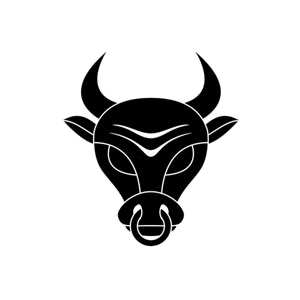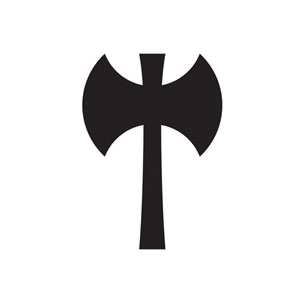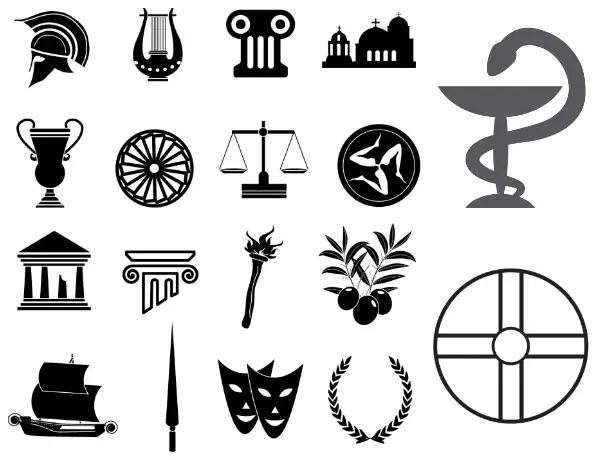Collection of ancient and modern Roman Symbols
 The Mano Fico – The mano fico, also called Figa, is an Italian amulet of ancient origin. Examples have been found from the Roman era, and it was also used by the Etruscans. Mano means “hand,” and fico or Figa means “fig,” with the idiomatic slang connotation of a woman’s genitals. (An English slang equivalent might as well be “vagina hand.”) It represents a hand gesture in which the thumb is thrust between the curled index and middle fingers in an obvious imitation of heterosexual intercourse. The Mano Fico – The mano fico, also called Figa, is an Italian amulet of ancient origin. Examples have been found from the Roman era, and it was also used by the Etruscans. Mano means “hand,” and fico or Figa means “fig,” with the idiomatic slang connotation of a woman’s genitals. (An English slang equivalent might as well be “vagina hand.”) It represents a hand gesture in which the thumb is thrust between the curled index and middle fingers in an obvious imitation of heterosexual intercourse. |
 The Asclepius wand or Asclepius rod is an ancient Greek symbol associated with astrology and with healing the sick through medicine. The rod of Asclepius symbolizes the healing arts by combining the serpent, which is shedding its skin as a symbol of rebirth and fertility, with the staff, a symbol of authority befitting the god of Medicine. The snake wrapped around the staff is widely claimed to be a species of rat snake, Elaphe longissima, also known as the Aesculapian or Asclepian snake. It is native to southeastern Europe, Asia Minor, and some central European spa regions, apparently brought there by Romans for their healing properties. The Asclepius wand or Asclepius rod is an ancient Greek symbol associated with astrology and with healing the sick through medicine. The rod of Asclepius symbolizes the healing arts by combining the serpent, which is shedding its skin as a symbol of rebirth and fertility, with the staff, a symbol of authority befitting the god of Medicine. The snake wrapped around the staff is widely claimed to be a species of rat snake, Elaphe longissima, also known as the Aesculapian or Asclepian snake. It is native to southeastern Europe, Asia Minor, and some central European spa regions, apparently brought there by Romans for their healing properties. |
 The Solar Cross or Sun Cross features a circle around a cross; the solar cross has many variations, including the one on this page. It is an ancient symbol, carvings of which were found in 1980 on the basis of Bronze-age burial urns at Southworth Hall Barrow, Croft, Cheshire, England, and the urns date back to circa 1440 BC. This symbol has been used throughout history by different religions, groups, and families (as a Japanese samurai family crest), eventually working its way into Christian iconography. The Solar Cross or Sun Cross features a circle around a cross; the solar cross has many variations, including the one on this page. It is an ancient symbol, carvings of which were found in 1980 on the basis of Bronze-age burial urns at Southworth Hall Barrow, Croft, Cheshire, England, and the urns date back to circa 1440 BC. This symbol has been used throughout history by different religions, groups, and families (as a Japanese samurai family crest), eventually working its way into Christian iconography. |
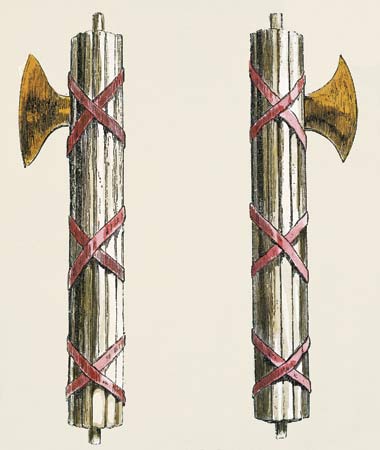 Fasces, a plural tantum, from the Latin word Fasces, symbolizes summary power and jurisdiction and “strength through unity.” Fasces, a plural tantum, from the Latin word Fasces, symbolizes summary power and jurisdiction and “strength through unity.”The traditional Roman fasces consisted of a bundle of white birch rods tied together with a red leather ribbon into a cylinder, and often including a bronze axe (or sometimes two) amongst the rods, with the blade(s) on the side, projecting from the bundle. In many circumstances, it was used as a symbol of the Roman Republic, including being carried in processions, much the way a flag might be carried today. |
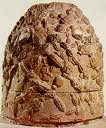 The Omphalos – An omphalos is an ancient religious stone artifact or Baetylus. In Greek, the word omphalos means “navel” (compare the name of Queen Omphale). According to the ancient Greeks, Zeus sent out two eagles to fly across the world to meet at its center, the “navel” of the world. Omphalos stones used to denote this point were erected in several areas surrounding the Mediterranean Sea; the most famous of those was at the oracle in Delphi. The Omphalos – An omphalos is an ancient religious stone artifact or Baetylus. In Greek, the word omphalos means “navel” (compare the name of Queen Omphale). According to the ancient Greeks, Zeus sent out two eagles to fly across the world to meet at its center, the “navel” of the world. Omphalos stones used to denote this point were erected in several areas surrounding the Mediterranean Sea; the most famous of those was at the oracle in Delphi. |
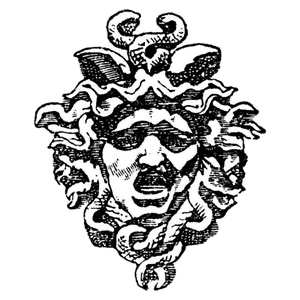 The Gorgon In Greek mythology, a so-called Gorgon, transl. Gorgo or gorgon, “terrible” or, according to some, “loud-roaring,” was a vicious female monster with sharp fangs, a protective deity from early religious concepts. Her power was so strong that anyone attempting to look upon her would be turned to stone; therefore, such images were put upon items from temples to wine kraters for protection. The Gorgon wore a belt of serpents intertwined as a clasp, confronting each other. There were three of them: Medusa, Stheno, and Euryale. Only Medusa was mortal; the other two were immortal. The Gorgon In Greek mythology, a so-called Gorgon, transl. Gorgo or gorgon, “terrible” or, according to some, “loud-roaring,” was a vicious female monster with sharp fangs, a protective deity from early religious concepts. Her power was so strong that anyone attempting to look upon her would be turned to stone; therefore, such images were put upon items from temples to wine kraters for protection. The Gorgon wore a belt of serpents intertwined as a clasp, confronting each other. There were three of them: Medusa, Stheno, and Euryale. Only Medusa was mortal; the other two were immortal. |
 The labyrinth In Greek mythology, the Labyrinth (Greek labyrinthos) was an elaborate structure designed and built by the legendary artificer Daedalus for King Minos of Crete at Knossos. Its function was to hold the Minotaur, a half man and half bull creature that was eventually killed by the Athenian hero Theseus. Daedalus had cunningly made the Labyrinth so he could barely escape it after he built it. Theseus was aided by Ariadne, who provided him with a fateful thread, literally the “clew,” or “clue,” to rewind his way. The labyrinth In Greek mythology, the Labyrinth (Greek labyrinthos) was an elaborate structure designed and built by the legendary artificer Daedalus for King Minos of Crete at Knossos. Its function was to hold the Minotaur, a half man and half bull creature that was eventually killed by the Athenian hero Theseus. Daedalus had cunningly made the Labyrinth so he could barely escape it after he built it. Theseus was aided by Ariadne, who provided him with a fateful thread, literally the “clew,” or “clue,” to rewind his way. |
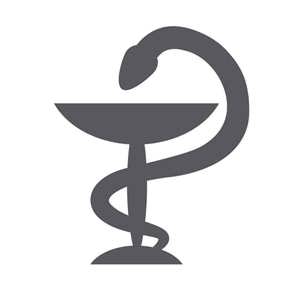 The Bowl of Hygeia The “Bowl of Hygeia” symbol is the most widely recognized international pharmacy symbol. In Greek mythology, Hygeia was the daughter and assistant of Aesculapius (sometimes spelled Asklepios), the God of Medicine and Healing. Hygeia’s traditional symbol was a bowl containing a medicinal potion with the serpent of Wisdom (or guardianship) partaking in it. This is the same serpent of Wisdom which appears on the caduceus, the staff of Aesculapius, which is the symbol of medicine. The Bowl of Hygeia The “Bowl of Hygeia” symbol is the most widely recognized international pharmacy symbol. In Greek mythology, Hygeia was the daughter and assistant of Aesculapius (sometimes spelled Asklepios), the God of Medicine and Healing. Hygeia’s traditional symbol was a bowl containing a medicinal potion with the serpent of Wisdom (or guardianship) partaking in it. This is the same serpent of Wisdom which appears on the caduceus, the staff of Aesculapius, which is the symbol of medicine. |
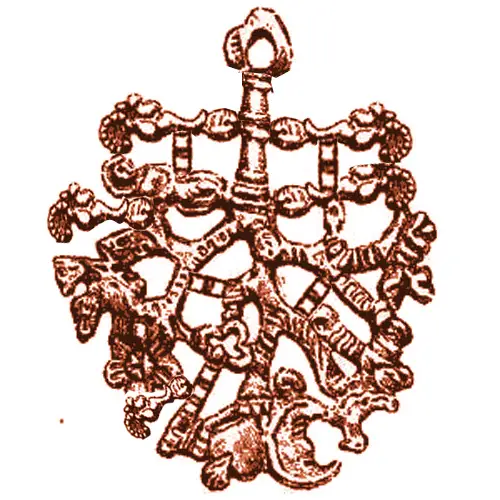 Cimaruta – This is an ancient Italian amulet that is typically hung over an infant’s crib or worn around the neck. It is supposed to offer protection from the evil eye. It means the ‘sprig of rue’ and refers to one of the most sacred Italian plants. The charm is made from silver and shaped like a rue sprig with three main branches. These symbolize the triple aspect of the moon goddess (Diana Triformis) as a maiden, mother & crone. Several small charms hang on the tips of the branches, such as the key that represents access to knowledge and power, a fish that is symbolic of fertility and abundance, a hand to fend off evil effect, a flower for protection, and the crescent moon representing the horns of God. Cimaruta – This is an ancient Italian amulet that is typically hung over an infant’s crib or worn around the neck. It is supposed to offer protection from the evil eye. It means the ‘sprig of rue’ and refers to one of the most sacred Italian plants. The charm is made from silver and shaped like a rue sprig with three main branches. These symbolize the triple aspect of the moon goddess (Diana Triformis) as a maiden, mother & crone. Several small charms hang on the tips of the branches, such as the key that represents access to knowledge and power, a fish that is symbolic of fertility and abundance, a hand to fend off evil effect, a flower for protection, and the crescent moon representing the horns of God. |
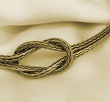 The Knot of Hercules, also known as Heracles Knot, Love Knot, and Marriage Knot, is a famous Roman and Greek protective charm. This strong knot, made with two intertwined ropes, was considered an important part of a Roman bride’s wedding dress. Hercules was regarded as the guardian of married life, and so the Knot of Hercules became symbolic of a happy and fruitful marriage. It was tied around the bride’s waist and could be untied only by her husband. As the Knot of Hercules symbolized lasting love and commitment, it came to be used as love tokens during medieval times. The Knot of Hercules, also known as Heracles Knot, Love Knot, and Marriage Knot, is a famous Roman and Greek protective charm. This strong knot, made with two intertwined ropes, was considered an important part of a Roman bride’s wedding dress. Hercules was regarded as the guardian of married life, and so the Knot of Hercules became symbolic of a happy and fruitful marriage. It was tied around the bride’s waist and could be untied only by her husband. As the Knot of Hercules symbolized lasting love and commitment, it came to be used as love tokens during medieval times. |

